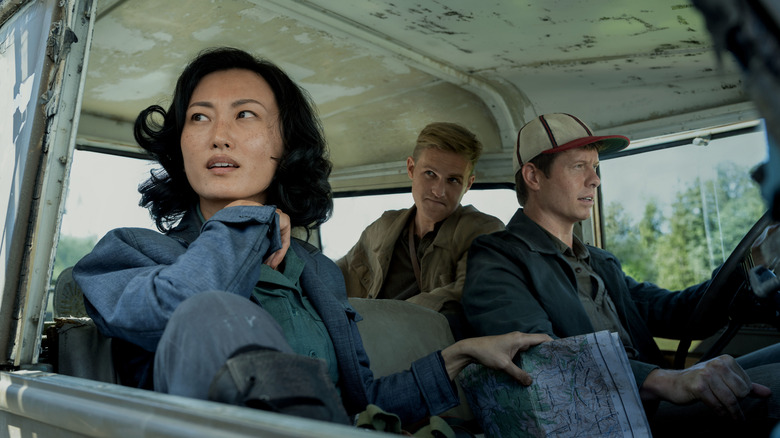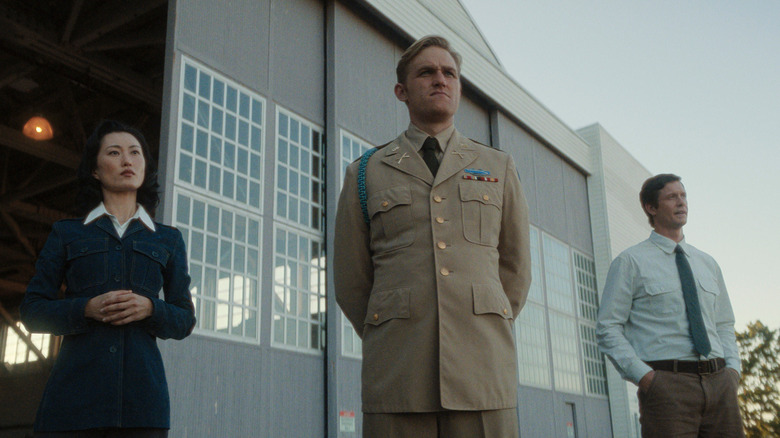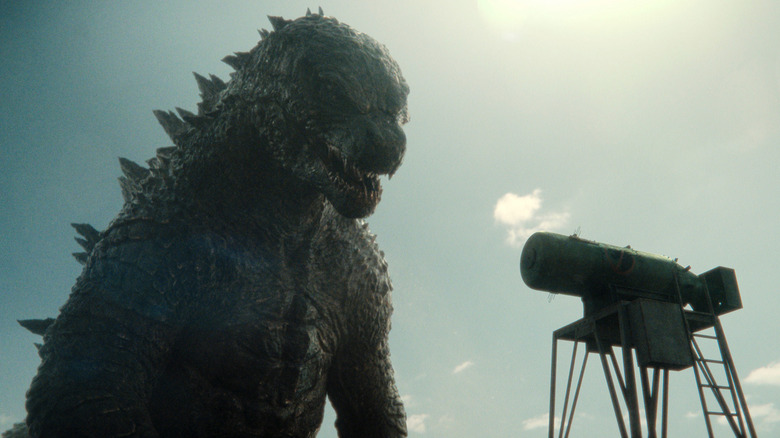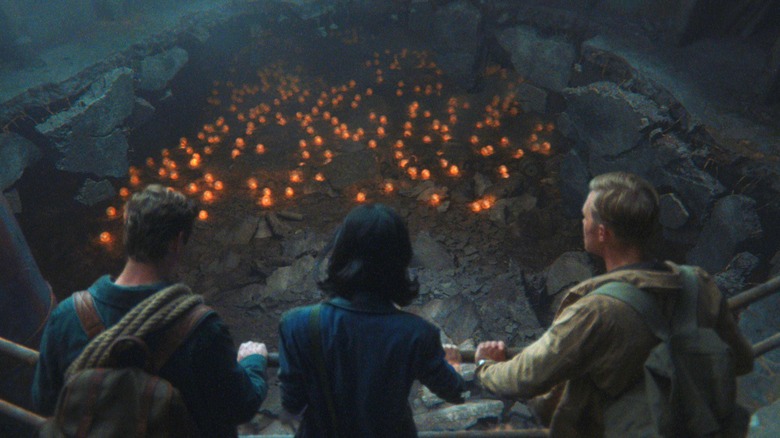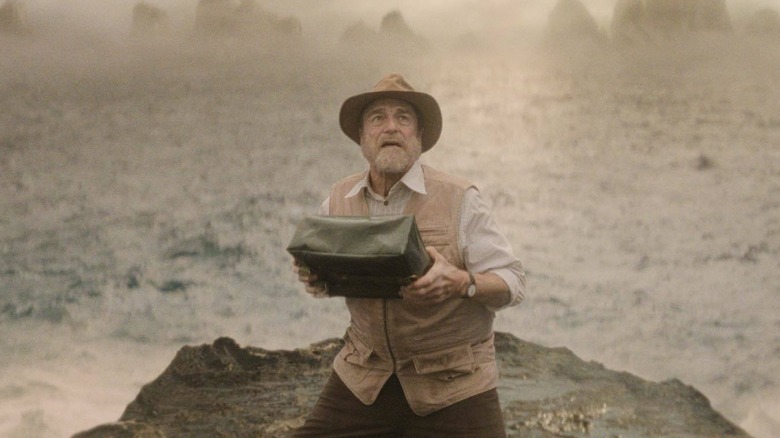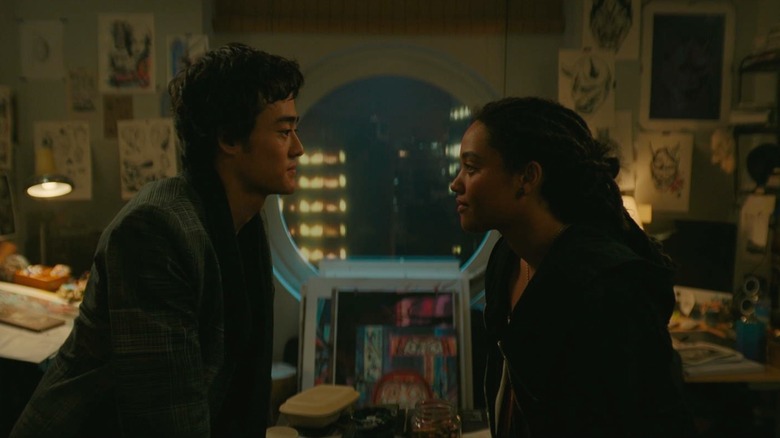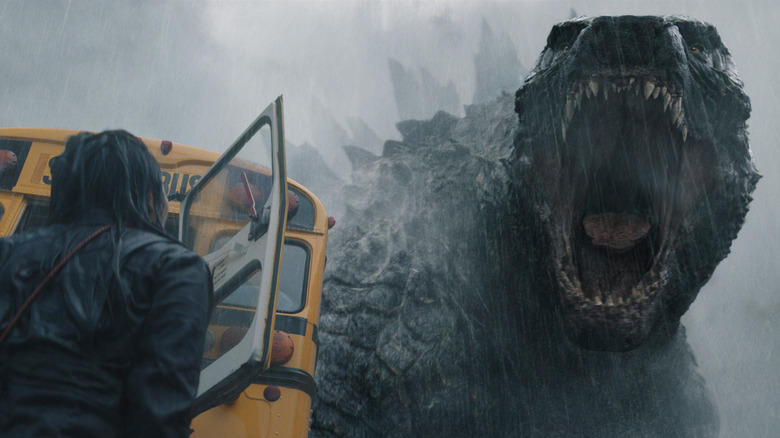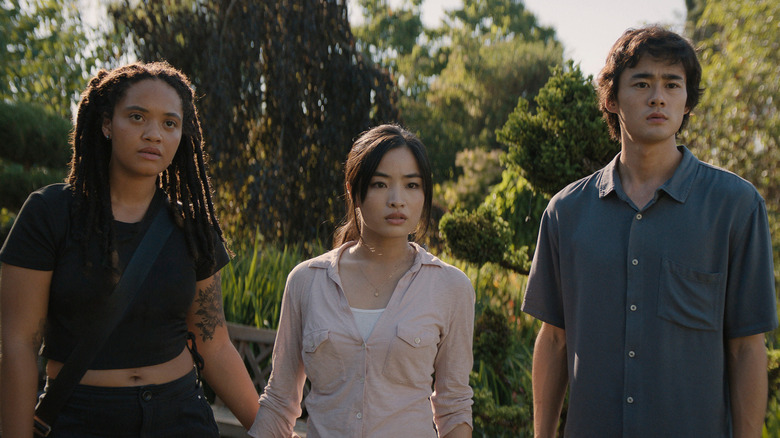Monarch: The Godzilla Show's Confusing Timeline Explained
This article contains spoilers for "Monarch: Legacy of Monsters"
"Monarch: Legacy of Monsters" has already added a ton of significant lore to the MonsterVerse, and it's done so across the saga's lengthy timeline. Through various flashback scenes, we see the formation and early days of Monarch, the first Titan sightings, G-Day, and the backstories of young protagonists Cate (Anna Sawai), Kentaro (Ren Watabe), and May (Kiersey Clemons). But with all the jumping around and the main present-day plot, that timeline can be a bit difficult to follow at times.
At its core, "Monarch" is a dual narrative. There's the present-day storyline, set in the year after G-Day (2014), and the story of how Monarch came to be, which takes place mostly in the 1950s. A few other stray scenes show other moments in the timeline, but the main two arcs are anchored by Kurt and Wyatt Russell's Lee Shaw character. While not the main character, Shaw is the axis around which the story revolves, and he's the glue that ties the disparate time periods together.
However, "Monarch" doesn't exactly follow a linear pattern, and the various one-off flashbacks make things even more complicated. So without further ado, let's break down the timeline of "Monarch: Legacy of Monsters" chronologically and sort out when everything really takes place.
The founding of Monarch (1952)
The earliest moments in the first five episodes of "Monarch" occur in 1952. Lee Shaw is reprimanded by his commanding officer, General Puckett (Christopher Heyerdahl), for fighting with other soldiers during his assignment in Manila. We see that the soldiers in question were harassing a local woman, and Shaw took it upon himself to take them down a peg. He then gets reassigned to the Philippines on protection duty for Dr. Keiko Miura. Their adventure into the jungle leads them to William Randa (Anders Holm) and, eventually, to a Titan known as the Ion Dragon.
It's not entirely clear if the encounter with Randa was truly a coincidence or if he somehow knew they were coming. The exact origins of Monarch are still a bit foggy in the MonsterVerse timeline. The organization doesn't seem to exist yet when the three meet, but it's not stated explicitly whether or not they directly created it. In other MonsterVerse media, other characters have been credited with helping to find the secret group.
Regardless of the exact origins, it's clear that Shaw, Keiko, and Bill are the core of Monarch in its early days. They eventually petition the government for additional resources, but it's not until the Army's first encounter with Godzilla that everyone else begins to realize how important Monarch's work is.
Bikini Atoll (1954)
The historical nuclear weapons tests at Bikini Atoll have often been made a critical part of the Godzilla story. That's true in Toho's latest live-action outing, "Godzilla Minus One," and it's also true in the MonsterVerse. In Gareth Edwards' "Godzilla," which kicked off the Legendary Pictures series, we see that the King of the Monsters was attacked by the U.S. military with a nuclear weapon at Bikini Atoll in 1954. "Monarch" shows that scene in much more detail.
After Shaw, Bill, and Keiko convince the Army of Godzilla's existence, the higher-ups decide it's best to destroy the creature. To that end, they set up a trap at Bikini Atoll, with a nuclear bomb positioned strategically to lure in and then destroy the creature. It's a brutal scene in the show, as Keiko tries desperately to convince the Army not to go through with the plan. She only says that she wants to protect the Titan so that it can be studied further, but it's clear she's also devastated to see yet another life be claimed by America's atomic violence.
The bomb goes off and Godzilla vanishes, assumed dead by military command. But of course, 'tis but a scratch. The kaiju simply retreats into the deep.
The death of Keiko Miura (1959)
In the very first episode of "Monarch: Legacy of Monsters," we see what appears to be the end of Keiko Miura's life. In 1959, the core Monarch trio travels to Kazakhstan in search of a possible Titan. A defunct nuclear power plant is the target, but when they arrive, they realize that the radiation that should be rampant in the air is gone. This signals the presence of a Titan, so they venture into the facility to investigate.
Inside, they discover a nest of what appear to be eggs. Shaw and Keiko descend to get a better look, but the Titans — smaller, human-sized, vicious bugs — emerge from their stasis and attack. The two try to climb back up as quickly as they can, but Keiko gets overwhelmed by the monsters and pulled back down, appearing to die a gruesome death.
Lines in the present-day timeline state that she died when her son Hiroshi (Takehiro Hira) was still a little boy. In the Jeep ride to the Kazakhstan facility, Bill and Keiko discuss their young son, so the timing lines up.
Bill Randa's final message (1973)
The actual opening of "Monarch: Legacy of Monsters" takes place in 1973 in the middle of the expedition depicted in "Kong: Skull Island." An older William Randa, played as he is in the movie by John Goodman, records a message on his camera in the middle of the jungle. "Hey buddy," he says. "I don't know if this'll get to you. I hope so. Actually, I don't, because it'll probably mean I'm dead, which you may not feel too busted up about." It's unclear who exactly he's talking to, but given the "buddy," it's probably his son, Hiroshi.
Clearly, the two aren't on great terms at this point in time, when Hiroshi would be a young adult. It's likely that after Keiko's death, Bill poured himself even deeper into his work. "You may never forgive me for what I took from you," he says. "And I can't go back in time and fix all the mistakes I made. But maybe I can leave something for the future. A legacy. And you'll realize it was all worth it." It seems clear that Bill blames himself for Keiko's death, and perhaps Hiroshi does, as well. Either way, they never get to talk about it in person again. Bill survives his encounter with two Titans in the intro sequence and throws his pack of valuable recordings into the sea. But if you've seen "Kong: Skull Island," you'll know that he meets his death soon after in the jaws of a Skullcrawler.
Because the message is vague, it's also possible that Bill was recording it for Lee Shaw. But again, the "buddy" at the start suggests he's talking to his son.
Kentaro meets May and Bill Randa's pack is found (2013)
The next point we see on the timeline in the first five episodes of "Monarch: Legacy of Monsters" is just a couple of years before the main events of the story. Episode 4, "Parallels and Interiors," explores Kentaro's backstory and shows how he met May. While stewing in anxiety over his first proper art show, he randomly bumps into her on the street in Tokyo. The two have an immediate chemistry and end up spending the evening together, drinking, talking, and eventually going back to Kentaro's apartment.
These scenes take place a year before the main story, as the captions tell us. That would put it sometime in 2013 or early 2014. It also means that May and Kentaro saw each other for a substantial amount of time before taking a break. The art show takes place well before G-Day, as Hiroshi is still around (though not in the ways Kentaro would like).
This isn't the only 2013 scene we get in the show, though. In Episode 1, right after the flashback of Bill Randa on Skull Island, we jump forward to 2013 and see his discarded pack of Monarch records get recovered by a Japanese fishing boat. It's unclear how exactly the pack got from the deck of a fishing trawler to Hiroshi in less than a year, but it's the same pack found by Kentaro and Cate when they search their father's Tokyo office. Clearly, Bill only bought the best gear for it to have survived at sea for so long.
Cate faces Godzilla on G-Day (2014)
MonsterVerse fans will be intimately familiar with G-Day — the climactic confrontation between Godzilla and the MUTOs in San Francisco. But just for good measure, "Monarch" shows it again, this time from the perspective of Cate Randa.
Through flashbacks, we see that Cate was a teacher at the time and that she was stationed on a school bus escorting kids out of the city on the day of the attack. But it turns out that taking the Golden Gate Bridge is a bad idea when there's a kaiju war happening. The Golden Gate sequence appears in Gareth Edwards' "Godzilla," but it's redone in a far more intimate way here, with Cate staring helplessly into the Titan's gaping maw as the bridge collapses around her. She's powerless to save the children under her care, as the bus tumbles horrifically down into the water below. On her way off the bridge, she sees Monarch agents and hardens her heart against their apparent excitement.
Later flashbacks in Episode 5 reveal that Cate had a lot more going on then. In the days leading up to G-Day, she was preparing to move in with her girlfriend, a fellow teacher named Dani. But it turns out that Cate was cheating on Dani, sabotaging her relationship on purpose. They split up on G-Day, and since Dani hasn't been mentioned anywhere else, it's unclear if she died or is simply out of the picture. Regardless, it's obvious that Cate has several different layers of guilt that are all tied up in Monarch and the Titans. She lashes out at others and puts on a mean front, but she probably hates herself more than anything.
The modern-day adventure (2014-2015)
The main action of "Monarch: Legacy of Monsters" takes place in the year following G-Day — less than a year after, as Kentaro and May's relationship began a year prior but before the battle in San Francisco. This sets the story in late 2014 or early 2015.
It can't have been that long, since Cate would have probably acquired her father's mysterious keys soon after his disappearance. This quickly leads her to Japan, gets her tied up with Monarch, and eventually sends her on the globetrotting adventure to Alaska and beyond. Because there are still several years between this point in the timeline and "Godzilla: King of the Monsters," the writers have a lot of room to explore. That gap also bodes well for a Season 2 — something MonsterVerse would surely love to see.
One of the more curious implications of the timeline is Lee Shaw's advanced age. He should be in his early 90s in 2015, but he looks far younger, and Kurt Russell himself is only 72. When May asks Shaw about this, he brushes it off by saying that he has good genes, but there's likely something more mysterious going on beneath the skin.
